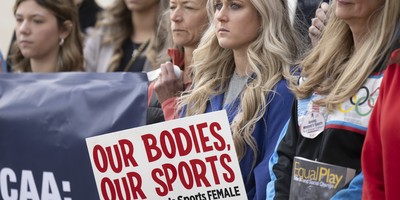Twenty years ago, the Berlin Wall came tumbling down. If Humpty Dumpty had been sitting on top of it, not Soviet soldiers, nor Stasi spies could put Humpty together again. It wasn't the end of history, as some liked to call it, but rather like history on a pause button that showed the world in one powerful moment that some of the evil that men do can be undone.

It is a coincidence not lost on political philosophers that the Wall fell on the same date as Kristallnacht in 1938, when the Nazi's -- with lots of help from "otherwise decent people" -- smashed windows and storefronts of Jewish homes and businesses, set fire to synagogues, and looted and plundered Jewish property, writing Adolf Hitler's preface for the Holocaust.
On Nov. 9-10, more than 20,000 Jews were stuffed into trucks like cattle and transported to concentration camps such as Buchenwald and Dachau. Buchenwald was located in East Germany, and it is with tragic irony that during the years that Germany was a divided country, East Berliners were taught that Buchenwald was not a camp where thousands of Jews died, but where the Nazi's imprisoned "good" Communists such as Ernest Thalmann, chairman of the pre-war Communist Party. History, like politics, is local first.
The deaths of 6 million Jews have been catalogued and documented and are mourned in memorials and museums. Individual fatalities of those attempting to escape over the Wall are smaller in number and less well-known.
The Berlin Wall Memorial is now gathering documents for an outdoor exhibit called "Windows of Remembrance," which opens next year and will include pictures and profiles of the 139 men and women who died seeking freedom on the other side of the wall. Many of their names were temporarily lost to history because the East German regime labeled them fugitives and criminals, and tried to hide the ruthless way they were killed.
Recommended
Nearly all were unarmed. Some were shot in the back running toward the wall. Others died from gunshots while swimming across the Spree or sneaking across train tracks in "ghost stations" sealed shut in East Berlin. Officials quickly had their bodies cremated, often before their families knew of their deaths to identify them.
I have read some of their stories from the Stasi files now open to the public, and they not only reveal a brutal regime viciously cutting off, families, friends and neighbors, but also tell poignant stories about the way the misfortunes of history affect people personally in their hearts and minds.
"History fatally intersected with the fate of a single individual," says the sister of Peter Fechter. She sought prosecution for the guards who shot and killed her brother, whose unheeded screams for help went on for almost an hour as he lay dying at the foot of the Wall in a neighborhood that had once been Berlin's lively newspaper quarter.
To its credit, Germany has documented the atrocities of the Holocaust and is now meticulously identifying every person who died trying to flee the tyranny of the East after the wall went up, including Ida Siekmann, who jumped out of her third floor window right in front of the Wall when she realized that the barbed wire and cement that was climbing up in front of her apartment building was meant to deny her freedom. She was the first to die when the border was closed.
After the wall fell, many of the border guards responsible for killing innocents were brought into court and found guilty of manslaughter, but because they had been only 19 years old and had committed crimes legalized by the state, most of them were sentenced to little more than a year or two of probation.
Some recited the familiar refrain that they were merely following orders. Others said they did what they were trained (indoctrinated) to do.
Of course, some people successfully escaped from East Berlin, and we'll probably never learn the names of those guards on duty who refused to take an innocent life. (Many border guards also found opportunities to flee.)
The 20th century was witness to great horrors against humanity, inflicted by the state collectively and by individuals. Daniel Jonah Goldhagen, in his new book "Worse Than War: Genocide, Eliminationism and the Ongoing Assault on Humanity," observes succinctly what is true for both genocide and murder: "People make choices about how to act, even if they do not choose the contexts in which they make them."
As we recall Kristallnacht and what followed in the Holocaust, we wonder how such things happen. When we celebrate the fall of the wall and think about other kinds of walls that are continually being built between people and countries, we look for ways to prevent them. We can ask, along with Goethe, the German poet who understood the importance of second chances for fallen man in "Faust," his masterpiece, "We all grow old -- but who grows wise?"
























Join the conversation as a VIP Member